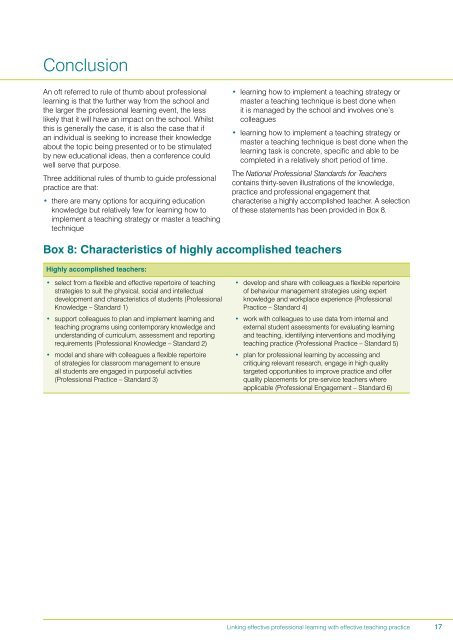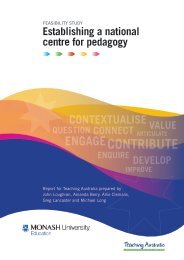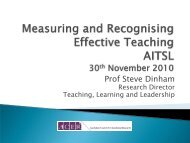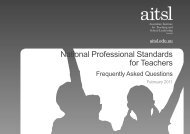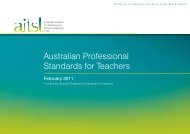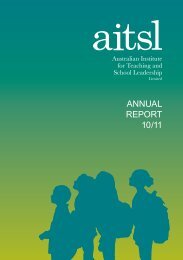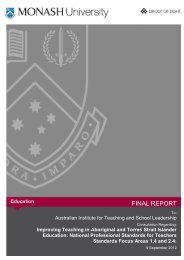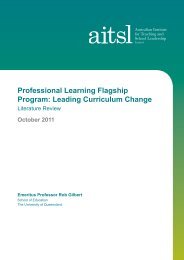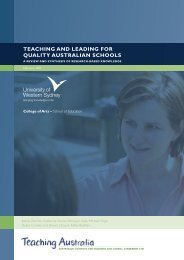One of the reasons for the poor linkage between<strong>professional</strong> <strong>learning</strong> and changed classroom<strong>practice</strong> is that often <strong>professional</strong> <strong>learning</strong> intentions,as documented in teachers’ <strong>professional</strong> <strong>learning</strong>plans, are described in generic terms – such as,to improve boys’ <strong>learning</strong> or to become better atpromoting cooperative <strong>learning</strong>. The more generic thedescription of a teacher’s <strong>professional</strong> <strong>learning</strong> needthe greater the likelihood that the teacher will havedifficulty identifying what to focus on first and what<strong>professional</strong> <strong>learning</strong> activities they should participatein. However, this problem is significantly lessenedif the teacher’s <strong>learning</strong> intention is described <strong>with</strong>more precision by wherever possible identifying aparticular <strong>teaching</strong> strategy they wish to implement ora particular <strong>teaching</strong> technique they wish to master.Teaching strategies and techniques which can relateto classroom instruction or classroom managementare sub-sets of <strong>teaching</strong> <strong>practice</strong>The difference between a <strong>teaching</strong> strategy and<strong>teaching</strong> technique is that a strategy is a generalisedapproach to problems and a way to inform decisions;whereas a technique is something you do or sayin a particular way. And because a technique is anaction, the more it is <strong>practice</strong>d the better the teachergets at performing it. By focusing on concrete actionsthat generally can be understood and implementedin a relatively short period, and then improved overtime, <strong>teaching</strong> capacity is built step by step and thearmoury of strategies and techniques available to theteacher is extended.Individual and group <strong>professional</strong> <strong>learning</strong> plansbecome highly <strong>effective</strong> tools for promoting teachercollaboration and classroom improvement when theyare practical, action oriented and contain specific ‘bitesized’ <strong>learning</strong> tasks that are to be completed <strong>with</strong>ina 10 week timeframe. Such a <strong>professional</strong> <strong>learning</strong>plan would include the one or two research-based<strong>teaching</strong> <strong>practice</strong>s that the teacher wishes to acquireor refine; the research-based <strong>professional</strong> <strong>learning</strong>strategies that the teacher plans to use to enablethem understand the <strong>teaching</strong> strategy or techniqueand how to apply it; and the timeline <strong>with</strong>in whichthe new <strong>practice</strong> will become part of the teacher’sclassroom instruction.The adoption of a ‘bite-sized’ <strong>learning</strong> task meansthat it is not too time consuming to learn and nottoo daunting to implement in one’s classroom. Italso means that <strong>professional</strong> <strong>learning</strong> plans can beregularly renewed as <strong>learning</strong> tasks are translated inclassroom <strong>practice</strong>. In this way, teacher improvementis a continuous process of accumulating expertisein evidence-based instructional and studentmanagement strategies and techniques.When determining the <strong>teaching</strong> strategies andtechniques that the school will adopt as its preferredset of <strong>teaching</strong> <strong>practice</strong>s, schools have turned to theadvice provided by education departments and tothe growing number of books on <strong>effective</strong> <strong>teaching</strong>that have moved beyond describing what an <strong>effective</strong>teacher does to describing how to implement <strong>effective</strong><strong>practice</strong>s. Robert Marzano and Doug Lemov areamong the most prominent in the current collectionof authors 24 who have been successful in extractingfrom numerous research studies those <strong>teaching</strong><strong>practice</strong>s that are most <strong>effective</strong> in promoting studentachievement.Marzano nominates nine general instructionalcategories and 34 specific behaviours and organisesthese strategies into a framework of <strong>effective</strong>instructional design and Lemov nominates forty-nine‘essential techniques’ which can be mastered oneat a time and which operate in synergy to produceexceptional <strong>teaching</strong>. Many schools are using theseevidence-based, micro-<strong>teaching</strong> <strong>teaching</strong> strategiesand techniques as the content for their <strong>professional</strong><strong>learning</strong> plans.Teachers in these schools are assuming greatercontrol of their own <strong>professional</strong> <strong>learning</strong> by focusingon a couple of <strong>teaching</strong> strategies and techniquesat a time and conducting teacher-led <strong>professional</strong><strong>learning</strong> activities that introduce and then helpto improve the application of these <strong>practice</strong>s inclassrooms across the school. These strategies andtechniques are also what teachers look for whenconducting instructional walk-throughs and classroomobservations.By doing this, schools are successfully linking<strong>effective</strong> <strong>professional</strong> <strong>learning</strong> <strong>practice</strong>s <strong>with</strong> <strong>effective</strong><strong>teaching</strong> <strong>practice</strong>s and thereby optimising the<strong>effective</strong>ness of their <strong>professional</strong> <strong>learning</strong>.24 For example, Cleveland, 2011, Cole 2008, Hattie, 2008, Lemov, 2010, Lewis, 2011, Linan-Thompson and Vaughn, 2007, Marzano, 2001,2003 and 2007, Marzano et al, 2005, Munro, 2002, Petty, 2009, Rogers, 2011 and Tomlinson, 2001.16 <strong>Linking</strong> <strong>effective</strong> <strong>professional</strong> <strong>learning</strong> <strong>with</strong> <strong>effective</strong> <strong>teaching</strong> <strong>practice</strong>
ConclusionAn oft referred to rule of thumb about <strong>professional</strong><strong>learning</strong> is that the further way from the school andthe larger the <strong>professional</strong> <strong>learning</strong> event, the lesslikely that it will have an impact on the school. Whilstthis is generally the case, it is also the case that ifan individual is seeking to increase their knowledgeabout the topic being presented or to be stimulatedby new educational ideas, then a conference couldwell serve that purpose.Three additional rules of thumb to guide <strong>professional</strong><strong>practice</strong> are that:• there are many options for acquiring educationknowledge but relatively few for <strong>learning</strong> how toimplement a <strong>teaching</strong> strategy or master a <strong>teaching</strong>technique• <strong>learning</strong> how to implement a <strong>teaching</strong> strategy ormaster a <strong>teaching</strong> technique is best done whenit is managed by the school and involves one’scolleagues• <strong>learning</strong> how to implement a <strong>teaching</strong> strategy ormaster a <strong>teaching</strong> technique is best done when the<strong>learning</strong> task is concrete, specific and able to becompleted in a relatively short period of time.The National Professional Standards for Teacherscontains thirty-seven illustrations of the knowledge,<strong>practice</strong> and <strong>professional</strong> engagement thatcharacterise a highly accomplished teacher. A selectionof these statements has been provided in Box 8.Box 8: Characteristics of highly accomplished teachersHighly accomplished teachers:• select from a flexible and <strong>effective</strong> repertoire of <strong>teaching</strong>strategies to suit the physical, social and intellectualdevelopment and characteristics of students (ProfessionalKnowledge – Standard 1)• support colleagues to plan and implement <strong>learning</strong> and<strong>teaching</strong> programs using contemporary knowledge andunderstanding of curriculum, assessment and reportingrequirements (Professional Knowledge – Standard 2)• model and share <strong>with</strong> colleagues a flexible repertoireof strategies for classroom management to ensureall students are engaged in purposeful activities(Professional Practice – Standard 3)• develop and share <strong>with</strong> colleagues a flexible repertoireof behaviour management strategies using expertknowledge and workplace experience (ProfessionalPractice – Standard 4)• work <strong>with</strong> colleagues to use data from internal andexternal student assessments for evaluating <strong>learning</strong>and <strong>teaching</strong>, identifying interventions and modifying<strong>teaching</strong> <strong>practice</strong> (Professional Practice – Standard 5)• plan for <strong>professional</strong> <strong>learning</strong> by accessing andcritiquing relevant research, engage in high qualitytargeted opportunities to improve <strong>practice</strong> and offerquality placements for pre-service teachers whereapplicable (Professional Engagement – Standard 6)<strong>Linking</strong> <strong>effective</strong> <strong>professional</strong> <strong>learning</strong> <strong>with</strong> <strong>effective</strong> <strong>teaching</strong> <strong>practice</strong>17


